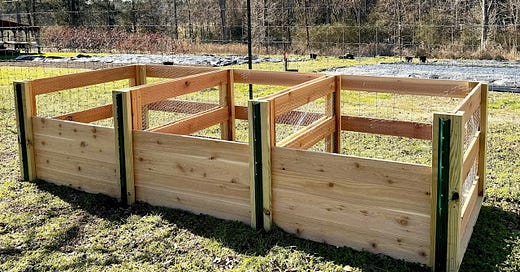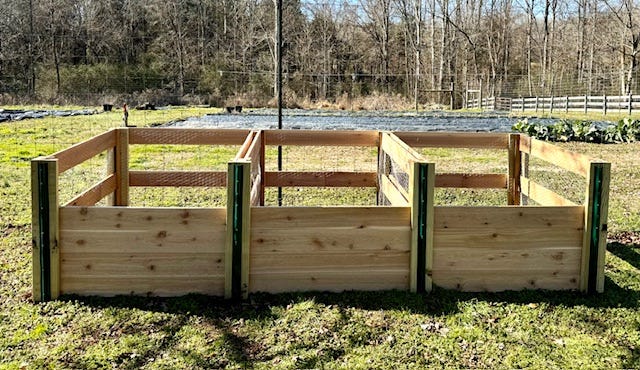If you’re compost-curious and want to learn more about building a streamlined system for composting food scraps and green waste on a larger scale – then you’re in the right place, keep reading! (And if you could care less about compost and just want my next recipe, you may want to skip this one, and I’ll be back on Friday with a new seasonal recipe).
This winter, we finally completed a project that’s been on our to-do list for years, which was to build a 3-bay compost system. And goodness gracious, she’s a thing of beauty! (See Exhibit A below). Now that we’ve successfully built our new fancy schmancy composting system, I want to share what we’ve learned, including the full materials list and instructions for building this exact set-up.
But first! Let’s take a step back and go over *the basics of composting.
*Full disclosure, I don’t have time in this post to cover the nitty gritty nuances of composting, but I’ll go over the basics + share lots of links and resources for anyone looking to dive deeper into the wild world of composting.
BASICS OF COMPOSTING
What even is composting?
Composting is the practice of recycling organic matter (like leaves, excess plant matter, and food scraps) into a rich soil amendment via the process of decomposition. When you compost, you’re basically creating an ideal environment that speeds up the rate of decomposition.
What are the ideal “ingredients” to create compost?
Composting is all about getting the right balance of nitrogen-rich “green” ingredients (think food scraps, excess garden materials, grass clippings, etc) vs carbon-rich “brown” ingredients (like dead leaves, sticks, straw, and paper).
The *ideal carbon-to-nitrogen ratio for a compost pile is 30 parts carbon for every 1 part nitrogen (by weight). *But don’t overthink this ratio! Basically, you just want more carbon-rich (brown) items than nitrogen-rich (green) items in your pile (too much nitrogen/green stuff, and your pile may turn slimy, smelly, and overly wet).
What household/garden items should NOT go into a compost pile?
Any bones, meat, or fish products
Dairy products
Cooking grease
Any plant matter that is diseased or pest-laden
What’s the basic process for composting?
MIX – combine a mix of carbon and nitrogen rich materials together (again, ideally more carbon-rich/brown stuff than nitrogen-rich/green stuff).
MASH – break up your “ingredients” into small pieces (if possible), which will help speed up decomposition.
MOISTEN – add water as needed to add moisture to the compost pile (you don’t want it soaking wet, just moist).
MOVE – “turn” the compost pile regularly to aerate and increase biologic activity.
How do you know when compost is “done”?
Finished compost will look like dark, rich soil and it should smell earthy and sweet. The original materials should be unrecognizable (because they will have fully decomposed), and it should be cool to the touch.
A note that it’s easy to get overwhelmed by the science and nuances of composting! Don’t overthink it. (Now, if your goal is to make the absolute highest quality compost possible, then yes, it should be closely monitored for moisture and temperature, and you’ll want to use a compost thermometer). However, for the casual home gardener, don’t be afraid to just get started and you can figure it out as you go.
How does a 3-bay composting system work?
A 3-bay compost system enables you to have 3 different piles of compost in various stages of “doneness” – with the bins arranged side by side for easy turning from one bin to the next.
You always add “fresh” scraps/ingredients to one end of the system, and as the materials start to break down and fill up in the first bay, you use a shovel or pitchfork to turn the materials from the first bay over to the second bay. As the second bay breaks down, you will eventually turn the materials from the second/middle bay over to the third and final bay to “finish” the compost.
A 3-bay composting system has a larger capacity to create high quality compost, and “turning” the pile is very straightforward when using this system.
COMPOSTING IN A SMALL FOOTPRINT
Curious to start composting, but don’t have room to build a 3-bay set-up? Here are some alternatives:
Just make a pile! (Video tutorial)
ADDITIONAL RESOURCES
The Composting Bible - book by Jeff Binder
Let It Rot: The Gardener’s Guide for Composting – book by Stu Campbell
Backyard Composting 101 from NC Extension
I just discovered
– a rad newsletter from that digs into all things compost. Be sure to check out her collection of posts on how to compost for beginners here.
HOW TO BUILD A 3-BAY COMPOST BIN
To learn how to build this 3-bay compost bin, continue reading for a full tools/materials list and detailed assembly instructions:






